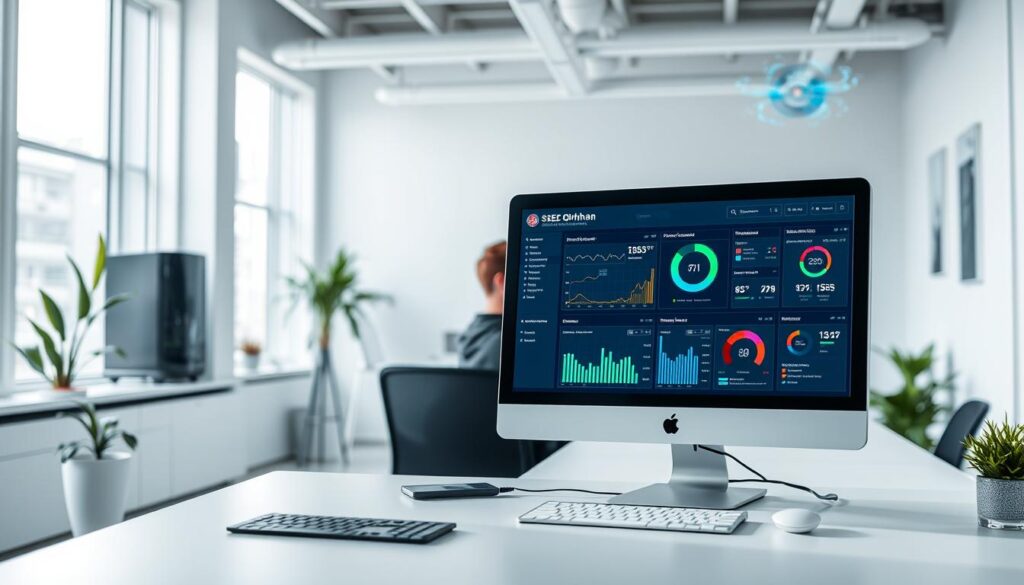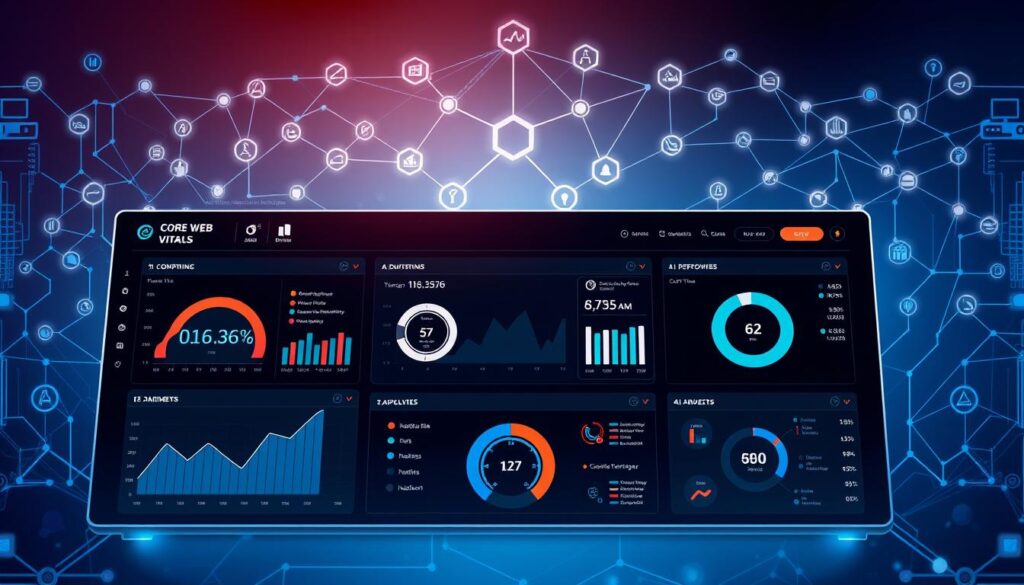Have you ever wondered why some websites load faster and keep users engaged while others struggle to retain visitors? The answer lies in understanding key metrics that shape your site’s performance. Metrics like Largest Contentful Paint (LCP) and Cumulative Layout Shift (CLS) play a crucial role in determining how users interact with your content.
These metrics, often referred to as Core Web Vitals, are essential for improving your site’s speed and user experience. A slow-loading page or unexpected layout shifts can frustrate users, leading to higher bounce rates and lower conversions. But how can you effectively address these issues and enhance your site’s performance?
This article explores actionable strategies to optimise your website’s performance. From leveraging real-time analytics to understanding the importance of LCP, you’ll discover practical steps to boost your search engine ranking and improve user engagement. Let’s dive into the techniques that can make your site faster, more responsive, and user-friendly.
Key Takeaways
- Core Web Vitals are critical for enhancing user experience and site performance.
- Largest Contentful Paint (LCP) should be under 2.5 seconds for optimal results.
- Cumulative Layout Shift (CLS) scores below 0.1 ensure a stable browsing experience.
- Improving these metrics can reduce bounce rates and increase conversions.
- Real-time analytics tools provide actionable insights for performance optimisation.
Understanding AI Core Web Vitals and Their Role in Website Performance
What makes a website truly stand out in terms of speed and responsiveness? The answer lies in mastering the metrics that define its performance. These metrics, known as Core Web Vitals, are the backbone of a seamless browsing experience.
What Are Core Web Vitals?
Core Web Vitals are a set of measurable factors that assess how well a site performs. They focus on three key areas: loading speed, interactivity, and visual stability. The primary metrics include:
- Largest Contentful Paint (LCP): Measures how quickly the main content loads. A good score is under 2.5 seconds.
- Interaction to Next Paint (INP): Tracks how responsive a page is to user actions. Aim for a score below 100 milliseconds.
- Cumulative Layout Shift (CLS): Evaluates visual stability. A score under 0.1 ensures elements don’t move unexpectedly.
Importance for SEO and User Experience
These metrics aren’t just technical jargon—they directly impact your site’s success. Poor scores can lead to higher bounce rates and lower conversions. For instance, a half-second delay in loading can cause a 20% drop in user engagement.
Search engines like Google prioritise sites with strong Core Web Vitals. Improving these metrics can boost your search engine ranking, driving more traffic to your site. Tools like PageSpeed Insights and Chrome DevTools provide actionable recommendations to enhance performance.
By focusing on these factors, you can create a site that not only ranks well but also keeps users engaged and satisfied.
Harnessing AI to Optimise Page Speed
In today’s fast-paced digital landscape, page speed is no longer just a technical concern—it’s a critical factor for user satisfaction and business success. Slow-loading pages can frustrate visitors, leading to higher bounce rates and lost conversions. Fortunately, advanced tools and technologies are now available to help you tackle these challenges effectively.

Automated Analysis and Real-Time Insights
One of the most powerful ways to improve page speed is through automated analysis. Tools like Google Lighthouse and New Relic use sophisticated algorithms to identify performance bottlenecks. These tools provide detailed reports on issues such as image loading delays, inefficient JavaScript execution, and other factors that slow down your site.
Real-time insights are another game-changer. By continuously monitoring your site’s performance, these tools enable you to address issues as they arise. This proactive approach minimises the negative impact of slow load times on your business. For example, a half-second delay in loading can reduce user engagement by 20%, but with real-time data, you can make swift fixes to prevent such losses.
Actionable metrics are key to prioritising improvements. Tools like Lighthouse offer clear recommendations, such as optimising images or minifying CSS files. By focusing on these tangible results, you can ensure your site delivers a seamless user experience and maintains a competitive edge.
Embracing these technologies is essential in today’s competitive environment. As highlighted in this AI-powered SEO and Core Web Vitals guide, integrating advanced tools into your strategy can significantly enhance your site’s performance and drive growth.
Boost Your Largest Contentful Paint (LCP) with AI Innovations
How quickly your site loads can make or break your user’s experience. Largest Contentful Paint (LCP) is a critical metric that measures how fast the main content appears on your page. A slow LCP can frustrate users, leading to higher bounce rates and lost conversions.
Optimising LCP is essential for improving user experience and search engine rankings. Studies show that pages with an LCP score under 2.5 seconds see a 20% increase in engagement. Let’s explore strategies to enhance your LCP and keep your visitors satisfied.
Strategies for Image and Asset Optimisation
Images and other large assets often slow down your site. Compressing images and using modern formats like WebP can significantly reduce load times. Tools like Lighthouse provide actionable insights on which assets need optimisation.
Advanced technologies can predict which files require compression or format changes. For example, AI-powered tools analyse your site’s performance and suggest improvements. This proactive approach ensures your content loads swiftly, enhancing user experience.
Leveraging Content Delivery Networks (CDNs)
CDNs are a game-changer for improving LCP. They store your site’s assets on servers located near your users, reducing latency. This means your content loads faster, regardless of the user’s location.
For instance, a study found that using a CDN improved LCP scores by 30%. This directly translates to better engagement and higher conversions. Integrating a CDN into your strategy is a practical step towards optimising your site’s performance.
| Strategy | Impact on LCP |
|---|---|
| Image Compression | Reduces load time by up to 50% |
| CDN Integration | Improves LCP by 30% |
| Modern Image Formats | Decreases file size by 25% |
For a detailed guide on mastering LCP, check out this step-by-step resource. Implementing these strategies will ensure your site delivers a seamless and engaging experience.
Enhancing Interactivity: Reducing Bounce Rates through AI
What if your website could respond instantly to every user interaction? A seamless browsing experience hinges on how quickly your site reacts to clicks, taps, and scrolls. This is where Interaction to Next Paint (INP) comes into play. It measures the time between a user’s action and the visual response, ensuring your site feels snappy and responsive.

INP is a critical metric for user experience. A slow response can frustrate visitors, leading to higher bounce rates and lost conversions. Studies show that sites with an INP score below 100 milliseconds see a 20% increase in engagement. Optimising this metric is essential for keeping users engaged and satisfied.
Explaining Interaction to Next Paint (INP)
INP replaces the older First Input Delay (FID) metric, offering a more comprehensive view of interactivity. While FID measured the initial delay, INP tracks the entire interaction process. This includes processing the input, updating the page, and displaying the result. A low INP score ensures your site feels responsive and smooth.
For example, if a user clicks a button, INP measures how quickly the button’s action completes and the page updates. Delays here can make your site feel sluggish, driving users away. Tools like Lighthouse provide actionable insights to improve INP, helping you create a more engaging experience.
Minimising JavaScript Delays
JavaScript delays are a common culprit behind poor interactivity. Heavy scripts can block the main thread, slowing down responses. To address this, defer non-critical JavaScript until after the page loads. This ensures essential content renders quickly, improving user experience.
Another effective strategy is optimising code execution. Minifying JavaScript files and removing unused code can significantly reduce load times. Advanced tools can predict and smooth interactions before delays become noticeable, ensuring your site remains responsive.
By focusing on these improvements, you can reduce bounce rates and boost engagement. A responsive site not only keeps users happy but also contributes to better search engine rankings. Start optimising your interactivity today and watch your site’s performance soar.
Achieving Visual Stability with AI-Powered Solutions
Visual stability is a cornerstone of a seamless browsing experience, but how can you ensure your site maintains it? Unexpected layout shifts can frustrate users, leading to higher bounce rates and lost conversions. This is where Cumulative Layout Shift (CLS) comes into play. It measures how much your page’s elements move during loading, and a low score is essential for retaining user trust.

Managing Cumulative Layout Shift (CLS)
CLS is a critical metric for user experience. When elements like images or buttons shift unexpectedly, it disrupts the browsing flow. Common causes include images without defined dimensions, dynamically injected content, and late-loading fonts. These issues can make your site feel unstable, driving users away.
AI-driven solutions can detect and mitigate these shifts automatically. For example, tools like Lighthouse analyse your site and provide actionable insights. They identify elements causing layout shifts and suggest improvements. This proactive approach ensures your site remains visually stable, enhancing user experience.
Setting explicit dimensions for media and reserving space for dynamic content are practical strategies. For instance, specifying width and height for images prevents them from pushing other elements around. Similarly, allocating space for ads or widgets ensures they load without disrupting the layout. These small changes can significantly improve your CLS score.
Data shows that sites with a CLS score below 0.1 see a 20% increase in engagement. A stable layout not only keeps users happy but also boosts your search engine rankings. By focusing on visual stability, you can create a site that’s both user-friendly and competitive.
AI-Driven Tools for Monitoring Core Web Vitals
Monitoring your website’s performance metrics in real-time can make a significant difference in user satisfaction. Tools like Google Lighthouse and Chrome DevTools provide actionable insights to optimise your site’s health. These tools are essential for identifying issues that impact loading speed, interactivity, and visual stability.

Using Google Lighthouse and Chrome DevTools
Google Lighthouse is a powerful tool that audits your site’s performance, accessibility, and SEO. It generates detailed reports, highlighting areas for improvement such as image optimisation and JavaScript execution. Lighthouse also offers synthetic testing, simulating how your site performs under various conditions.
Chrome DevTools, on the other hand, allows you to inspect and debug your site in real-time. It provides insights into network activity, rendering performance, and memory usage. Together, these tools help you address issues before they affect your users.
Interpreting Real User Data
While synthetic testing is useful, real-user monitoring (RUM) provides data from actual visitors. Tools like PageSpeed Insights and CrUX collect real-world performance metrics, offering a clearer picture of your site’s health. This data helps pinpoint issues that synthetic tests might miss, such as slow load times on specific devices or browsers.
Integrating these tools gives you a comprehensive view of your website’s performance. For example, combining Lighthouse’s recommendations with real-user data ensures you address both technical and user-centric issues. This approach leads to meaningful improvements in user experience and engagement.
For a deeper dive into effective tools for monitoring Core Web Vitals, check out this comprehensive guide. By leveraging these resources, you can ensure your site remains fast, responsive, and user-friendly.
Implementing Practical AI Strategies for Web Performance Improvement
What strategies can you implement to ensure your website not only loads quickly but also keeps users engaged? The answer lies in leveraging advanced tools and techniques that enhance website performance and improve user experience. By focusing on actionable recommendations and real-life case studies, you can achieve measurable improvements in your site’s metrics.
Actionable Recommendations for Optimising Performance
To boost your site’s speed and responsiveness, consider these practical steps:
- Optimise Assets: Compress images, use modern formats like WebP, and minify CSS and JavaScript files to reduce load times.
- Leverage CDNs: Content Delivery Networks store your site’s assets on servers closer to users, significantly reducing latency.
- Monitor Continuously: Use tools like Google Lighthouse to track performance metrics and identify areas for improvement.

Real-Life Case Studies: Success Stories
Several companies have successfully implemented these strategies to enhance their website performance:
| Company | Strategy | Outcome |
|---|---|---|
| Vodafone | Optimised assets and used CDNs | Improved load times by 30% |
| Yelp | Minified JavaScript and CSS | Increased engagement by 20% |
| Amazon | Continuous monitoring | Boosted conversions by 15% |
These examples highlight the tangible benefits of adopting AI-driven strategies. For instance, Vodafone’s focus on asset optimisation and CDNs led to a 30% improvement in load times, directly enhancing user experience.
The Importance of Continuous Improvement
Sustained performance gains require a blend of AI insights and regular technical audits. Tools like Lighthouse provide actionable recommendations, but iterative improvements are key to staying ahead. For example, Yelp’s commitment to minimising JavaScript delays resulted in a 20% increase in user engagement.
As highlighted in this guide on improving Core Web Vitals, regular monitoring and optimisation are essential for maintaining a competitive edge. By implementing these strategies, you can ensure your site delivers a seamless and engaging experience for every user.
Final Reflections on Maximising Your Website’s Performance with AI
Ensuring your website performs at its best is no longer optional—it’s a necessity for success. By leveraging advanced methodologies, you can enhance user experience, reduce bounce rates, and boost conversion rates. The strategies discussed earlier, from optimising assets to continuous monitoring, offer tangible improvements for your site’s performance.
Adopting these approaches ensures your website remains responsive and engaging. Tools like Google Lighthouse provide actionable insights, helping you address issues before they impact your audience. This proactive stance not only improves engagement but also strengthens your competitive edge.
Remember, performance optimisation is an ongoing process. Regular audits and adaptations are essential to maintain high standards. Combining advanced tools with manual checks ensures lasting improvements and a seamless experience for your users.
Take the next step in optimising your website. Explore further resources and strategies to keep your site at the forefront of website performance. Your users—and your business—will thank you.
FAQ
What are Core Web Vitals?
Why are Core Web Vitals important for SEO and user experience?
How does AI help improve page speed?
What strategies can AI offer for optimising Largest Contentful Paint (LCP)?
How does AI reduce bounce rates by enhancing interactivity?
What is Cumulative Layout Shift (CLS), and how does AI address it?
Which AI-driven tools can monitor Core Web Vitals?
What are some practical AI strategies for improving web performance?
Source Links
- Core Web Vitals: Essential Guide to Better Site Performance
- We Analyzed 208K Webpages. Here’s What We Learned About Core Web Vitals and UX
- Improving Google Page Speed Score & Core Web Vitals for Better Rankings – Digital Creatings
- Website Performance Monitoring: The Complete Guide | Splunk
- Web vitals – Docs – PostHog
- Learn about page loading performance data (web apps) | Firebase Performance Monitoring
- Robots Refresher: introducing a new series | Google Search Central Blog | Google for Developers
- Keeping It 100, Web Performance | Adobe Experience Manager
- Our Top 3 WordPress Speed Optimization Plugins | WEB ROI
- Google’s Core Web Vitals & Page Experience Update
- User Experience as a Ranking Factor for Search Engines: Google, Bing, and Beyond – WebPro Technologies LLP Ahmedabad
- Boost Your BigCommerce Site: Master Core Web Vitals
- How AI Helps Optimize UX for SEO – ALCC SEO World
- Why User Experience Matters for SEO: The Secret to Higher Rankings
- AI and Machine Learning: Lighting the Way for Optical Advancements
- Blog — The Science of Machine Learning & AI
- Multi-Agent System: Enhancing Collaboration in AI
- Application Insights OpenTelemetry overview – Azure Monitor
- Blog Overview | Botify
- Free SEO Website Audit | SEO Agency Near You | Guardian Owl Digital
- 16 Top Web Development Trends in 2025
- SEO in 2025: Tips And Tricks | Brand Vision
- Generative Engine Optimization (GEO) Archives
- SEO in 2025: How to Rank Higher and Beat the Competition
- AI-Powered FinOps: 8 Best Practices for Cloud Cost Optimization
- How to Use AI to Train Your Own Models (Use Cases & Tools)
